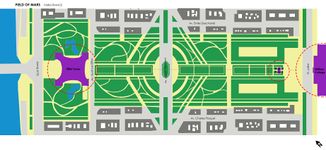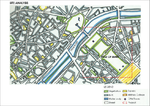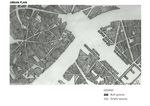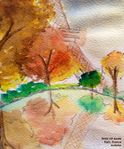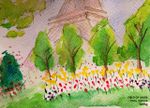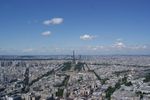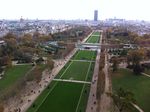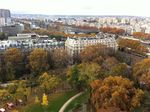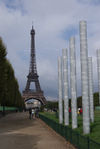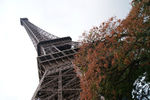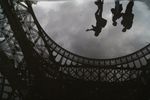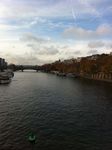Planting Design 2013 Working Group 27 - Case Study C
---> back to group page working group 27
Champ de Mars
| Name | Champ de Mars/ Field of Mars | |
| Location | Paris | |
| Country | France | |
| Authors | Luisa Colorado | |
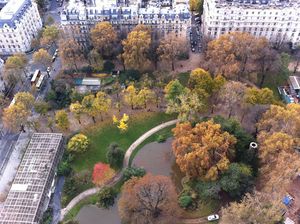
| ||
|
| ||
Rationale: Why is this case interesting?
Name: The Field of Mars (Champ de Mars)
Project: Urban open space (large public garden)
Location: Paris, France, between the Eiffel Tower and the Military School (École Militaire) to the southeast.
Size: (780x 220 Mts2)
This field is known for the design and important historical facts that took place there: “Federation day” Festival of the French Revolution (July 14, 1790), massacre on the Champ de Mars (July 17, 1791), in 1889 in the Expositions Universelles, Gustave Eiffel finished the construction of the Eiffel Tower and others.
- Why did you select it?
I select this case because is an excellent case of an urban open space in the middle of such important city as Paris, also for the important historical facts, the sightseeing and for the design itself. The Champ de Mars is a touristic public green space that provides an uninterrupted view of the Eiffel Tower; the park is bordered by beautiful gardens, wide walking paths crossing the lawns, the borders of the park are lined with variety of trees, flowering shrubs and scattered throughout the park are flowerbeds.
- Is it exemplary for a specific theme or a problem?
In the landscape area the project is exemplary because is an “Urban open space”. A green space regulated to serve conservation and urban shaping function in addition to proving recreational opportunities. The benefits for the citizens of the urban open spaces can be divided in tree:
1.Recreational These spaces are often appreciated because helps the citizen to find places inside the city in which they can find recreational passive or active opportunities, for example: organized sports or individual exercises.
2.Ecological The conservation of nature in an urban environment has direct impact on people health in different levels such as have fresh air, relaxing spaces, contact with the nature and balance between nature-buildings. The urban open spaces serve as island of nature, promoting biodiversity and providing a space for natural species in environments that are otherwise uninhabitable due to city development.
3.Aesthetic The aesthetic value of urban open spaces is evident, the people has the opportunity to enjoy viewing nature, especially when otherwise the landscape would by gray infrastructure.
- In how far does it relate to your life?
I come from Bogota-Colombia, a city with more or less 8 million populations, a city that does not has a large number of urban open spaces. This project is related to my own city, also to my life, inasmuch as I can realize the different between the urban open spaces in South America and Europe and how can my city improve their design in order to get a better place to live through the nature, green parks inside the urban spaces.
Author's perspective
I am architect, and through my years of studies the interest in the relation between human and nature has been growing, also the interest in places in which the people lives in big communities.
In this case “ Field of Mars”, I am interesting in study the relation between the man living in big cities, the nature create in a special place, the open urban spaces and how those places/spaces affects the live of the people in a good or in a bad way.
Historical context of your case
16th/17th_ Garden area where vegetables and grapes grew.
18th_ Training Ground for the École Militarie, a military academy. Napoleon was a student beetween 1784-1785.
End 18th_ The place began to be used as a sidefor festivals and other celebratons.
1790_ The first was the Celebration of the Federation, when Louis XVI accepted the ner written constitution. (July 14)
1791_Massacre on the Champs de Mars (July 17)
1837_ The Duke of Orleands was married.
1889_ Exposition Universelle, Gustave Eiffel finished the construction of the Eiffel Tower.
1890_The 42 hectareas park was redesigned by the architect Jean-Camille Fromigé, also the size was reducing.
20th_ The size was change again, 24.5 hectares.
Landscape and/or urban context of your case
Tourism
1.The Eiffel Tower (La Tour Eiffel)
Iron lattice tower located on the Fields of Mars. The tower was erected in 1889 as the entrance arch to the 1889 World’s Fair, the company of Gustave Eiffel design the tower and that is where the name come from; it has become a global cultural icon of France and one of the most recognizable structures in the world. With 324 m (1,063 ft) tall, the tower is the tallest structure in Paris and the most-visited paid monument in the world. The Eiffel Tower has tree levels for visitors, with restaurants and an observatory in the third level 276 m (906 ft) above the ground.[1]
2.Military school (École Militaire)
In 1765 Ange-Jacques Gabriel constructed a military training ground, called École Militaire. Initially, the training grounds were to be built south of the school. However, the choice to build an esplanade somewhere north of the school changed these plans. The result was that the military training drills were conducted on Grenelle. After some time the park was named Champ de Mars and was open to the public. Many young student men including Napoleon Bonaparte in 1794-1795 trained for war on these grounds.[2]
3.Monument to peace
The Wall for Peace was inspired by the Wailing Wall of Jerusalem. This modern memorial monument was created by Clara Halter and the architect Jean-Michel Willmotte and was constructed in 2000. It consists of 32 columns and two glass sculptures with the word “peace” written in 32 languages and 18 alphabets.[3]
- Touristic Places
Analytical drawings
Please add four analytical sketches/drawings (or montages/schemes) of your case and take the following aspects into account:
- natural dynamic versus cultural framework - in how far do these two forces come together in your case?
- dynamic through the year (you may imagine how the site looks in spring and summer, maybe you also remember it)
- highlight potentials and problems
- Analytical General Drawings
- Analytical Park Drawings
- Dynamic through the year
Projective drawings
- Now, In 1-2 years and in 10-15 years.
In 1-2 Years
Inasmuch as I do not think that the project will change a lot in the next 1-2 years from what is today, I would like to see more cultural options for the citizens and for the tourist; cultural options that let them know more about the historic importance of the place with expositions around the area, the process of construction and the important of itself.
Also I will like to see other cities in the world that does not have enough public open spaces see this project as an example, furthermore that those cities apply in their own urban areas examples like the Field of Mars, but taking into account their own geographical, cultural and social conditions.
In 10-15 Years
In 10-15 year the project could receive more citizens and tourist people than nowadays, also the park could have more and different kind of vegetation species and probably new cultural and touristic places. I imagine this place with hundred or thousand more people than today, because this space has being important and high visited since large time ago and with the time, with the facilities that has being created in travel and information, this kind of places would be more visited trough the years.
In the way that the project inspired other cities, it could be that other places in the world start to use this example in their own urban spaces with great successful.
Summary and conclusion
Field the Mars is an urban open space, a green regulated area inside of a big cosmopolitan city as Paris; this open space serves to the conservation, urban shaping function and also provides entertaining to the citizens and tourist that converge there.
The benefits of this project are recreational, in as much as the field offers a large opportunities of spaces for passive an active activities; ecological in order to conserves the nature in an urban environment and aesthetic value, because offers the possibility to enjoy view nature inside of a huge layers of constructions.
It is remarkable not just the ecological, recreational and aesthetical worth of the field, but also the historical and touristic importance, the Field of Mars is located between the Eiffel Tower and the Military school (École Militaire), really important events for the France people occurs in this field, such as the massacre in the Champs de Mars (July 17, 1791), the Expositions Universelles in 1889, when the Eiffel tower was finish and others.
In conclusion this kind of projects are essential for the urban spaces in which the green areas does not exist or are not enough; re-green the cities brings vegetation diversity to public open spaces making them a useful tool for urban and environment improve, also varying the options in a open space creates benefits for the recreation, health, besides the ecological, social and environment improvement.
Image Gallery
- Image Gallery
References
1. http://www.aviewoncities.com/paris/champdemars.htm
2. http://famouswonders.com/champ-de-mars/
3 http://www.paris-walking-tours.com/gardenofchampdemars.html
4. http://www.bodinestreetgarden.org/why-protect-urban-green-space/
About categories: You can add more categories with this tag: "", add your categories
